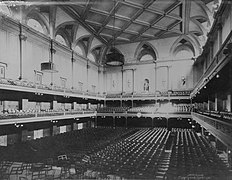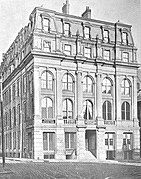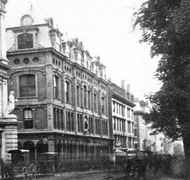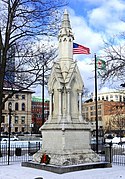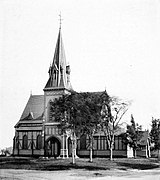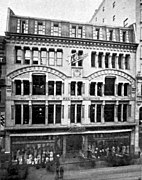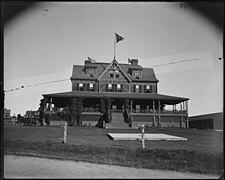User:JPRiley/Snell
| This is not a Wikipedia article: It is an individual user's work-in-progress page, and may be incomplete and/or unreliable. For guidance on developing this draft, see Wikipedia:So you made a userspace draft. Find sources: Google (books · news · scholar · free images · WP refs) · FENS · JSTOR · TWL |
George Snell | |
|---|---|
| Born | 1820 |
| Died | February 23, 1893 |
| Nationality | England |
| Occupation | Architect |
George Snell FAIA (1820-1893) was an English-American architect practicing in Boston, Massachusetts. He is best remembered as the architect of the Boston Music Hall, completed in 1852.
Life and career[edit]
George Snell was born in London in 1820. He attended King's College London, receiving special instruction in mechanics from Henry Moseley. He then entered the office of architect Harvey Lonsdale Elmes as a pupil. In 1846 he was awarded a Telford Medal by the Institution of Civil Engineers. In 1850, Snell immigrated to Boston, establishing an architectural practice upon his arrival. In late 1852 he formed a partnership with Alpheus C. Morse, another young architect with whom he had been associated in the design of the Boston Music Hall, though this was dissolved when Morse moved to Providence, Rhode Island the following year. Snell practiced alone until 1862, when he formed a partnership with James R. Gregerson. Gregerson had been in Snell's office since at least 1858.[1] Snell and Gregerson would be associated until Snell's death in 1893. Gregerson would continue the practice under his own name until his death in 1898.
From 1861 until Snell's death, his firm was located in Room 15 of the Studio Building, which he had designed in 1860. He also kept his residence in the building.
Personal life[edit]
Never married.
Member of the Somerset Club 1852 until his death.
Legacy[edit]
Snell was noted in his time as a mentor to young architects. Several well-known Boston architects were trained in his office, including Benjamin F. Dwight (1851-1852), Carl Fehmer (1854-1862),[3] Henry Van Brunt (1854-1857),[4] Charles D. Gambrill (1855-1857), George A. Clough (1863-1869),[5] J. Foster Ober (1864-1867)[1] and Herbert Jaques (1877-1880).[6] These were, however, only a few of many.[a]
Snell was well-known as a watercolorist, and frequently submitted paintings for exhibition in London and Boston between 1844 and at least 1875. One of his watercolors is now in the collection of the Metropolitan Museum of Art in New York.
Architectural works[edit]
Snell's best-known project was the Boston Music Hall, which was begun in 1851 and opened the following year.[11] In its time, it was one of the best concert halls, from an acoustic sense, in the United States. EXPAND
He was also responsible for the Oxford Hotel on Huntington Avenue, built in 1871 and demolished before World War I.[2] EXPAND (SECTION TO INCLUDE CITY HOUSES)
"The work of Snell and Gregerson...possesses a stylistic consistency too strong to pass unnoticed. ...While many of their contemporaries merely manipulated Classical forms, Snell and Gregerson, more perhaps than any other contemporary Boston firm, demonstrated a sympathy and understanding of orderly, Academic design. Although disciplined, their designs are not the rigid mechanical exercises which less gifted academicians so often produced in the name of Classicism. Usually they demonstrate a good deal of freedom and originality in handling Classical detail but these decorative variations never obscure the architectonic clarity of the composition. In their hands the French Academic formula is both dignified and adaptable."[12]
— Bainbridge Bunting, 1967.
Less is known about residential buildings designed by Snell outside of Boston. However, some suburban and country houses have been identified. In North Easton, he built two houses for members of the Ames family. For Frederick Lothrop Ames he designed "Langwater" in 1859,[13] and for Oliver Ames Jr. designed "Unity Close" in 1864.[14] Langwater was an early example of the Second Empire style in the United States, while Unity Close was more conventional. Both houses are standing, though Langwater has been altered several times.[b] He did work for the Codman family at "The Grange" in Lincoln, designing a carriage house and stable on that estate in 1870.[15] In 1871 he designed a country house for Erastus Brigham Bigelow, called "Stonehurst," at North Conway, New Hampshire.[16] This house was an example of the Stick Style.[c] Contemporary to Stonehurst, and in the same style, Snell designed a house in Brookline, Massachusetts for Henry Sayles of the Brookline Land Company.[18]
Snell was responsible for a number of commercial buildings in downtown Boston. The largest of these was the building of the Merchants' Bank on State Street, designed in 1856 in collaboration with Gridley J. F. Bryant. This monumental Granite bank was rebuilt by Snell and Bryant after being gutted by a fire in 1878.[19] It has since been demolished.[d] Snell was responsible for at least three buildings built in the aftermath of the fire of 1872, all in 1873 and in an elaborate Victorian Gothic style. These were for H. H. Hunnewell on Devonshire Street,[20] for Palmer, Bachelder & Company on Washington Street[21] and for the Shawmut National Bank on Congress Street.[22] All of these have been demolished. These were followed by the Dexter Building, in a similar style, on Washington Street in 1876.[23] This has also been destroyed. Two later commercial buildings are still standing. The earlier is the Warren Building, built on Park Street in 1877,[24] and the later the Park Building, built in Park Square in 1887.[25] Both of these are in the Italianate style.
Beyond these buildings for offices and financial institutions, Snell was also responsible for the Studio Building on Tremont Street. Begun in 1860 and completed in 1861, this was an elaborate Second Empire design, a home for artists based on the Studio Building in New York, designed by Richard Morris Hunt in 1857. It was noted in its time as a "very clever example of brick architecture."[2]
Snell is known to have designed only one church, the First Universalist Church of Shirley, Massachusetts, begun in 1869 and completed the following year.[26] This was designed in an eleborate Victorian variant of the Carpenter Gothic style. This church is extant, though the original surface detail has been covered by a layer of vinyl siding. In addition to this, in 1857 Snell was responsible for an extension to Christ Church in Cambridge, Massachusetts, originally designed by Peter Harrison and built in 1760. Under Snell's direction, the church was extended by two bays, copying Harrison's original design. He also designed, in 1858, a chapel for St. Paul's School in Concord, New Hampshire, extant and now known as the Old Chapel.[27]
Snell worked on another of Harrison's projects the following year, the Redwood Library and Athenaeum in Newport, Rhode Island. Snell was responsible for the addition of a large reading room behind the original building, again copying the original Palladian detail.[28] In 1873 Snell & Gregerson were selected to design the new Concord Free Public Library in Concord, Massachusetts.[15] As built, this was a Victorian Gothic building centered on an octagonal reading room.[e] The building's picturesque design was intended to evoke "a group of buildings rising successively one above another," or a Medieval village in miniature. In 1876 they entered the competition for the design of the new Woburn Public Library, though the commission was awarded to H. H. Richardson.[29] In addition to these libraries, in association with Henry Greenough, Snell was responsible for the design of Agassiz Hall, the home of the Museum of Comparative Zoology of Harvard University.[30] This was originally an austere Italianate box, though it has been greatly expanded and elaborated upon.[f] He also designed buildings for the use of charitable institutions, the Industrial School for Girls in Dorchester in 1859[15] and the Church Home for Orphan and Destitute Children in South Boston in 1868.[2] The former survives, but not the latter.
Snell was well-known on the Boston social scene, and was a member of many clubs in and around Boston. He designed buildings for at least two of them. He joined the Somerset Club in 1852,[31] and when the club bought the home of the late David Sears II in 1871 for its new clubhouse, Snell was the architect selected for renovations. Snell adapted the original house for club uses, and added a wing at the rear for dining and billiard rooms.[15] In 1871 he joined the Eastern Yacht Club in Marblehead, Massachusetts, and designed its new clubhouse in 1880.[32]
Snell designed several funerary monuments in Mount Auburn Cemetery.[33] In Mount Auburn Cemetery, he designed the monuments of Daniel Sharp in 1855[34] and of Robert Charles Winthrop in 1887.[35] He also designed a monument in honor of Timothy Bigelow in Worcester, Massachusetts, dedicated in 1861 on the Worcester Common.[36]
Gallery of architectural works[edit]
-
Merchants' Bank Building, Boston, Massachusetts, 1856.
-
Reading room, Redwood Library and Athenaeum, Newport, Rhode Island, 1858.
-
Studio Building, Boston, Massachusetts, 1860.
-
Monument to Timothy Bigelow, Worcester Common, Worcester, Massachusetts, 1861.
-
First Universalist Church, Shirley, Massachusetts, 1869.
-
Dexter Building, Boston, Massachusetts, 1876.
Gallery of artistic works[edit]
-
Wood Carrier, near Amalfi, 1878, collection of the Metropolitan Museum of Art.
Notes[edit]
- ^ Others who were trained or worked in Snell's office include: Theodore E. Colburn (1855-1859, Boston architect),[7] Charles Fessenden Morse (1857-1861, Kansas City businessman),[8] H. Floyd Faulkner (1861-1865, Boston architect),[1] John F. Eaton (1864, Boston architect),[1] Michael W. FitzSimmons (1867-1872, Supervisor of Plans, Boston Building Department),[1] R. Ralston Jones (1873-1875, Chicago engineer)[9], Warren P. Skillings (1886-1890, Seattle architect)[10] and J. St. Clair Harrold (1890-1892), Boston architect),[1] among others.
- ^ Built in the Second Empire style, but remodeled several times in the nineteenth century: in 1876 under the direction of John A. Mitchell and in 1899 by Shepley, Rutan & Coolidge. It now resembles a French chateau. The Langwater estate is home to a gate lodge built in 1880 to a design by H. H. Richardson. The estate was listed on the National Register of Historic Places in 1972 as part of the North Easton Historic District.
- ^ The current house was built from the original plans in 1877 after being destroyed by fire in 1875.[17].
- ^ Demolished in 1912 to build the new Merchants National Bank Building, designed by Shepley, Rutan & Coolidge.
- ^ In 1934 the library was encased by a new Georgian Revival building, designed by Harry B. Little of Frohman, Robb & Little. The original reading room, however, survives at the center.[15]
- ^ Twentieth-century construction has obscured the original Divinity Avenue facade.
References[edit]
- ^ a b c d e f Boston Directories, 1850-1893.
- ^ a b c d "Death of George Snell, Architect," American Architect and Building News 39, no. 897 (March 4 1893): 129-130.
- ^ "Carl Fehmer," in Biographical History of Massachusetts, vol. 6, ed. Samuel Atkins Eliot (Boston: Massachusetts Biographical Society, 1916)
- ^ "Van Brunt, Henry," in The National Cyclopedia of American Biography, vol. 11 (New York: James T. White & Company, 1909): 324.
- ^ "George A. Clough," in Massachusetts of To-day: A Memorial of the State, Historical and Biographical, Issued for the World's Columbian Exposition at Chicago, ed. Daniel P. Toomey and Thomas C. Quinn (Boston: Columbia Publishing Company, 1892): 230.
- ^ "News From the Classes," Technology Review 29, no. 1 (January 1917): 66-70.
- ^ Harvard College: Report of the Class of 1854 (Boston: George H. Ellis, 1894)
- ^ "Colonel Charles Fessenden Morse," in The United States Biographical Dictionary, vol. Kansas (Chicago and Kansas City: S. Lewis & Company, 1879): 141-142.
- ^ A. T. Andreas, "R. R. Jones," in History of Chicago, vol. 2 (Chicago: A. T. Andreas Company, 1885): 677.
- ^ Catalogue of the Delta Kappa Epsilon Fraternity: Biographical and Statistical (New York: Council Publishing Company, 1890): 211.
- ^ "The Boston Music Hall—Its Favorable Site—Execution of the Design," Dwight's Journal of Music 2, no. 7 (November 20 1852): 53-54.
- ^ Bainbridge Bunting, Houses of Boston's Back Bay: An Architectural History, 1840-1917 (Cambridge: Harvard University Press, 1967): 158.
- ^ North Easton Historic District NRHP Registration Form (1972)
- ^ "EST.10", mhc-macris.net, Massachusetts Historical Commission, n. d.
- ^ a b c d e Keith N. Morgan, Buildings of Massachusetts: Metropolitan Boston (Charlottesville: University of Virginia Press, 2009)
- ^ Bryant F. Tolles Jr., Summer Cottages in the White Mountains: The Architecture of Leisure and Recreation, 1870 to 1930 (Lebanon: University Press of New England, 2000)
- ^ "History," stonehurstmanor.com, Stonehurst Manor, n.d.
- ^ http://www.brooklinehistoricalsociety.org/tours/PillHill/tour.asp
- ^ "Merchants' National Bank Building, Boston, Mass.," American Architect and Building News 7, no. 216 (February 14 1880): 58.
- ^ "A Year's Work," Boston Daily Advertiser, November 28 1873, 4.
- ^ "Local Matters," Boston Daily Advertiser, November 11 1873, 1.
- ^ Asa S. Knowles, Shawmut: 150 Years of Banking, 1836-1986 (Boston: Houghton Mifflin Company, 1986)
- ^ J. Randolph Coolidge Jr.,"The Problem of the Store Front," Architectural Review 8, no. 7 (July 1901): 77-80.
- ^ "BOS.1933", mhc-macris.net, Massachusetts Historical Commission, n. d.
- ^ Charles S. Damrell, A Half Century of Boston Building (Boston: Louis P. Hager, 1895)
- ^ Seth Chandler, History of the Town of Shirley, Massachusetts, (Shirley: Seth Chandler, 1883)
- ^ Bryant F. Tolles Jr. and Carolyn K. Tolles, New Hampshire Architecture: An Illustrated Guide (Hanover and London: University Press of New England, 1979)
- ^ James L. Yarnall, Newport Through its Architecture (Hanover and London: University Press of New England, 2005)
- ^ Jeffrey Karl Ochsner, H. H. Richardson: Complete Architectural Works (Cambridge: MIT Press, 1982)
- ^ Bryant F. Tolles Jr., Architecture and Academe: College Buildings in New England Before 1860 (Lebanon: University Press of New England, 2011)
- ^ A Brief History of the Somerset Club of Boston (Boston: Somerset Club, 1914)
- ^ "At its Marblehead Neck Home: Eastern Yacht Club Today Celebrates 25 Years of Prosperous Growth," Boston Daily Globe, July 17 1895, 7.
- ^ "EST.10", mhc-macris.net, Massachusetts Historical Commission, n. d.
- ^ "WAT.9123", mhc-macris.net, Massachusetts Historical Commission, n. d.
- ^ "WAT.9015", mhc-macris.net, Massachusetts Historical Commission, n. d.
- ^ William Lincoln, History of Worcester, Massachusetts (Worcester: Charles Henry, 1862)


